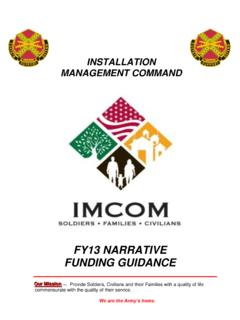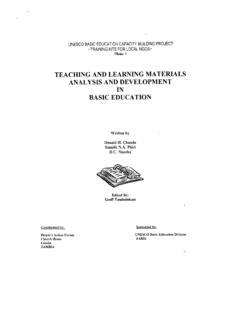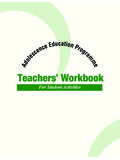Transcription of Ohio Department of Health Concussion Information …
1 OOhio Department of Health Concussion Information Sheet For Interscholastic Athletics Dear Parent/Guardian and Athletes, This Information sheet is provided to assist you and your child in recognizing the signs and symptoms of a Concussion . Every athlete is different and responds to a brain injury differently, so seek medical attention if you suspect your child has a concus-sion. Once a Concussion occurs, it is very important your athlete return to normal activities slowly, so he/she does not do more damage to his/her brain.
2 What is a Concussion ? A Concussion is an injury to the brain that may be caused by a blow, bump, or jolt to the head. Concussions may also happen after a fall or hit that jars the brain. A blow elsewhere on the body can cause a Concussion even if an athlete does not hit his/her head directly. Concussions can range from mild to severe, and athletes can get a Concussion even if they are wearing a helmet. Signs and Symptoms of a Concussion Athletes do not have to be knocked out to have a Concussion . In fact, less than 1 out of 10 concussions result in loss of consciousness.
3 Concussion symptoms can develop right away or up to 48 hours after the injury. Ignoring any signs or symptoms of a Concussion puts your child s Health at risk! Signs Observed by Parents of Guardians i Appears dazed or stunned. i Is confused about assignment or position. i Forgets plays. i Is unsure of game, score or opponent. i Moves clumsily. i Answers questions slowly. i Loses consciousness (even briefly). i Shows behavior or personality changes (irritability, sadness, nervousness, feeling more emotional). i Can t recall events before or after hit or fall.
4 Symptoms Reported by Athlete i Any headache or pressure in head. (How badly it hurts does not matter.) i Nausea or vomiting. i Balance problems or dizziness. i Double or blurry vision. i Sensitivity to light and/or noise i Feeling sluggish, hazy, foggy or groggy. i Concentration or memory problems. i Confusion. i Does not feel right. i Trouble falling asleep. i Sleeping more or less than usual. Be Honest Encourage your athlete to be honest with you, his/her coach and your Health care provider about his/her symptoms.
5 Many young athletes get caught up in the moment and/or feel pressured to return to sports before they are ready. It is better to miss one game than the entire or risk permanent damage! Seek Medical Attention Right Away Seeking medical attention is an important first step if you suspect or are told your child has a Concussion . A qualified Health care professional will be able to determine how serious the Concussion is and when it is safe for your child to return to sports and other daily activities. i No athlete should return to activity on the same day he/she gets a Concussion .
6 I Athletes should NEVER return to practices/games if they still have ANY symptoms. i Parents and coaches should never pressure any athlete to return to play. The Dangers of Returning Too Soon Returning to play too early may cause Second Impact Syndrome (SIS) or Post- Concussion Syndrome (PCS). SIS occurs when a second blow to the head happens before an athlete has completely recovered from a Concussion . This second impact causes the brain to swell, possibly resulting in brain damage, paralysis, and even death.
7 PCS can occur after a second impact. PCS can result in permanent, long-term Concussion symptoms. The risk of SIS and PCS is the reason why no athlete should be allowed to participate in any physical activity before they are cleared by a qualified healthcare professional. Recovery A Concussion can affect school, work, and sports. Along with coaches and teachers, the school nurse, athletic trainer, employer, and other school administrators should be aware of the athlete s injury and their roles in helping the child recover.
8 During the recovery time after a Concussion , physical and mental rest are required. A Concussion upsets the way the brain normally works and causes it to work longer and harder to complete even simple tasks. Activities that require concentration and focus may make symptoms worse and cause the brain to heal slower. Studies show that children s brains take several weeks to heal following a Concussion . h Rev. RReturning to Daily Activities 1. Be sure your child gets plenty of rest and enough sleep at night no late nights.
9 Keep the same bedtime weekdays and weekends. 2. Encourage daytime naps or rest breaks when your child feels tired or worn-out. 3. Limit your child s activities that require a lot of thinking or concentration (including social activities, homework, video games, texting, computer, driving, job related activities, movies, parties). These activities can slow the brain s recovery. 4. Limit your child s physical activity, especially those activities where another injury or blow to the head may occur. 5. Have your qualified Health care professional check your child s symptoms at different times to help guide recovery.
10 Returning to Learn (School) 1. Your athlete may need to initially return to school on a limited basis, for example for only half-days, at first. This should be done under the supervision of a qualified Health care professional. 2. Inform teacher(s), school counselor or administrator(s) about the injury and symptoms. School personnel should be instructed to watch for: a. Increased problems paying attention. b. Increased problems remembering or learning new Information . c. Longer time needed to complete tasks or assignments.








